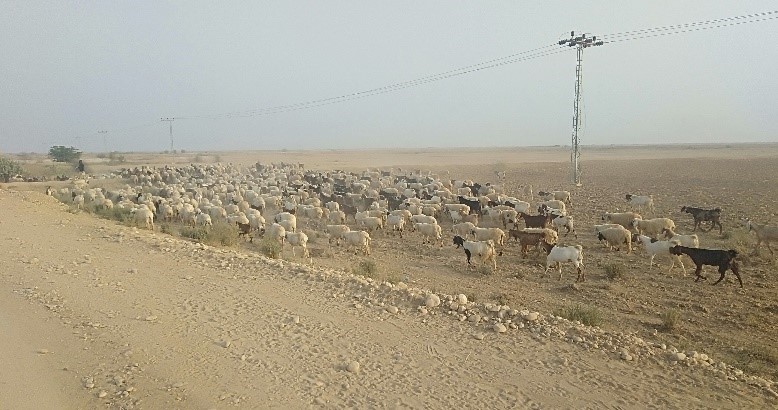
Should their pattern of lifestyle be changed or let it be as it is? In this changing environment, there is a dire need to develop policies to change the lifestyle of nomadic tribes
Prof Dr. Abdullah G Arijo
With nearly over 200 animals including, sheep, goats, and cattle, Zarina virtually came on the middle of the road heading towards Badin, Sindh. One moment, I thought otherwise, but the next moment, when she made a gesture of being thirsty, I got a sigh of relief and asked my driver to stop the car.
“Yes, lady,” I asked as to what the issue was. “Water”.
I gave her one after the other, but she asked for a third glass.
“You look too thirsty.” “Yes, I am” she replied.
“All these animals belong to you?” “Yes, they are all mine,” she replied and I started making a rough estimate of the total capital she had in the form of livestock – nearly 5000,000 (five million). So that poor lady was so wealthy but had zero realization as to what was the value of the animal stock, she was rearing.
I discussed a lot, but she had one reply – “We poor people”. Honestly, if I had this much stock, I would sell some and purchase a plot to have my home and rear my livestock but not roam in a cyclic way we call them Nomadic.
Nomadism is a way of life of people who do not live continuously at the same place but move cyclically or periodically. It is distinguished from migration, which is noncyclic and involves a total change of habitat.
These people never carry immovable property and carry along with the movable property i.e., livestock that travels from place to place to find postures for grazing their animals and have no permanent home. Nomads are exclusive livestock producers who grow no crop and depend solely on the sale or exchange of animals and their products to obtain foodstuffs.
The animals managed by nomadic herders include horses, sheep, goats, and cattle. For many nomads, their herds provide meat, milk, and heights for their own use, as well as for trade.
Nomads adopt this farming method to meet their own needs. Nomadic herding is permitted subsistence activity where herders move from one place to another, along with their livestock commercial. Commercial herding is rearing an organized activity that is practiced on permanent basis.
Nomadic pastoralism is a form of pastoralism in which livestock are herded to seek fresh pastures on which to graze. True nomads follow an irregular pattern of movement, in contrast to transhumance, where seasonal pastures are fixed.
There are certain countries where rearing livestock in a nomadic way is still the only way of life. Nomadic pastoralism is the practice of rearing livestock by moving with the animals from place to place in search of pasture. It is believed that the practice started because of the Neolithic revolution, also known as the first agricultural revolution. At the time, humans had just managed to domesticate some animals and therefore moved with them to places with green pastures. The nomadic way of life is still practiced by some communities in the least developed nations. Nomadic pastoralism is largely practiced in arid and semi-arid areas. Animals reared by nomadic pastoralists include sheep, goats, cattle, donkeys, camels, horses, reindeer, and llamas among others. Some of the countries where nomadic pastoralism is still practiced include Kenya, Iran, India, Somalia, Algeria, Nepal, Russia, and Afghanistan.
 In Sindh when it comes to nomadic life, its pattern of migration is dependent on domesticated animals for subsistence and predominantly occupied with herding on natural pasture, and is characterized as pastoral. Although some pastoralists rely on their herds more completely than others do, it is impossible to base subsistence solely on animals. Most pastoralists; therefore, supplement their diet by hunting, gathering, fishing, cultivating, or trading.
In Sindh when it comes to nomadic life, its pattern of migration is dependent on domesticated animals for subsistence and predominantly occupied with herding on natural pasture, and is characterized as pastoral. Although some pastoralists rely on their herds more completely than others do, it is impossible to base subsistence solely on animals. Most pastoralists; therefore, supplement their diet by hunting, gathering, fishing, cultivating, or trading.
To get crops, pastoralists either trade with cultivators or do some cultivating or gathering themselves. Most nomadic are characterized by similar patterns of husbandry, division of labor, rights in pastures and animals, forms of political organization, and cultural character. Yet they often share religion, language, and culture with settled communities to whom they are tied through descent, marriage, trade, and exchange.
The nomadic pastorals are found in Khirthar Mountain Range. The ethnic composition of the area consists of mostly Baloch castes and tribes. Some of the true nomadic sub-tribes are Malokhani, Khohira, Jarwani, and Bozdar in Wahi Pandhi and in Gorakh area are Halkhani, Bijarani, Brohi, Mirwari and Rind.
Certain studies suggest that in this region two patterns of movement occur with pastoralism – nomadism and transhumance. Both are based on the fact that herds must move to use pasture available in particular places in different seasons. In pastoral nomadism, the entire group— women, men, and children—moves with the animals throughout the year. The transhumance part of the group moves with the herds, but most people stay in the home village.
Studies reveal that there are three major types of grazing systems based on fieldwork: True Nomadic, Transhumant and Sedentary Pastorals. The true nomads follow the seasonal patterns of forage production, spending the summers in the low-temperature highlands of Khirthar and winters in the Kachho, the lowlands of Sindh. Transhumant means that the population moves seasonally in herds.
Should this pattern of lifestyle be changed or let it be as it is? In this changing environment, there is a dire need to develop policies to change the lifestyle of these scavengers with all the big worth they own in the form of livestock, these poor people will remain as such with the realization that this is their fate and future with no ray of hope.
________________
 Prof. (R) Dr. Abdullah G. Arijo is Advisor and Visiting Professor Shaheed Benazir Bhutto University of Veterinary and Animal Science, Sakrand, Sindh Pakistan. Formerly, he was Chairman, Department of Parasitology, Sindh Agriculture University Tando Jam. After retirement, he also served there as Advisor Academics & P&D to Vice Chancellor. He can be reached at Email: abdullaharijo.faculty@sbbuvas.edu.pk
Prof. (R) Dr. Abdullah G. Arijo is Advisor and Visiting Professor Shaheed Benazir Bhutto University of Veterinary and Animal Science, Sakrand, Sindh Pakistan. Formerly, he was Chairman, Department of Parasitology, Sindh Agriculture University Tando Jam. After retirement, he also served there as Advisor Academics & P&D to Vice Chancellor. He can be reached at Email: abdullaharijo.faculty@sbbuvas.edu.pk